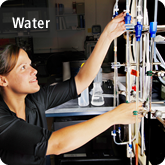
Solid-State Lighting Technology Challenges
To illustrate why commercial SSL lamps are only at 20% efficiency today, the Figure shows the anatomy of a common state-of-the-art commercial white solid-state lamp, along with the spectral power density of its emission. The lamp consists of a blue LED, 1-square-mm in size, driven with 0.7A of current, and coated with green and red phosphors. Some of the blue light leaks through the phosphors, giving the relatively narrow blue peak in the spectral power density. But some blue light is absorbed by the phosphors and is re-emitted as green and red light, giving the two relatively wide green and red peaks in the spectral power density. The combination of blue, green and red light is both pleasing to the human eye and faithfully renders colors of objects in the environment around us. The lamp’s 20% efficiency is due to the cumulative effect of three sub-efficiencies [1], discussed next.

- State-of-the-art white SSL: its anatomy on the left, its spectral power density on the right, and the technology challenges associated with major increases in efficiency listed as A-D.
The first sub-efficiency is that of the blue LED. This efficiency, 43%, is much less than the best thus-far-reported lab result, 81%, for a mm2 chip driven at a low current of 25 mA [2]. This is due to a poorly understood phenomenon called “efficiency droop,” which is a decrease in efficiency with increased injected current density. To defray the manufacturing cost of the SSL chip, one would like to drive the chip harder, at least at 700 mA and ideally at 2A into a into a mm2 chip. So a first SSL technology challenge is to increase blue LED efficiency, particularly at high current densities.
The second sub-efficiency, that of the phosphor and package, is about 56%. Some of this is because the phosphors do not have perfect quantum yield; that is, one blue photon in does not result in one red or green photon out. But quantum yields are improving, leaving the more fundamental efficiency loss, the so-called Stokes deficit, which is the quantum energy deficit associated with converting a blue into a red or green photon. One way of eliminating this loss is to eliminate phosphors altogether through use of direct electroluminescent (EL) emitters. However, the current state-of-the-art visible electroluminescent semiconductors, InGaN and InGaAlP, have low efficiencies in the red-yellow-green spectral range necessary for high color-quality white light. Thus, a second SSL technology challenge facing solid-state lighting is to fill the red-yellow-green gap in semiconductor electroluminescence.
The third sub-efficiency, associated with the match between the spectrum of emitted white light and the human eye sensitivity, is about 85%. To see why, note that the four sharp white spectral lines in the Figure represent a hypothetical 100%-efficient four-color RYGB source that gives the best combination of color rendering quality and match to the human eye response. The red phosphor used in this white lamp is centered at the ideal 615 nm wavelength, but emits farther into the deep red than the ideal red – so deep that the human eye is not very sensitive to it, as can be seen from the human eye response plotted just below. So, a third SSL technology challenge is to find an efficient narrow-linewidth red wavelength down-converter.
The fourth sub-efficiency, that associated with the inefficient manner in which light is used, is not normally included in discussions of lighting efficiency. However, it is important and has been estimated to be as low as 50-75% – that is to say, the “effective” efficiency of light usage is only 50-75% of what it could be if light were intelligently matched to its use. So, a fourth SSL technology challenge is creating high-functionality light, an example of which might be the development of tiny and inexpensive light-emitting chips whose output illuminance and chromaticity could be tailored in space and time, and that could be networked into a larger system that optimizes how the light is being used.
Although the first three sub-efficiencies may not seem unacceptably low (43%, 56% and 85%), due to their serial nature, their multiplicative effect is a net overall efficiency of 20%. If one were to include the fourth sub-efficiency, as a percentage of the best effective efficiency it would be lower still.
Overcoming the four SSL technology challenges is thus extremely important. Empirical approaches to overcoming them will undoubtedly advance SSL technology in the near-term. But the magnitude of these challenges are such that a deeper, fundamental research effort is desirable. That is, to build a scientific understanding of materials architectures and light-emission phenomena used in current-day SSL approaches, and to investigate new materials architectures and light-emission phenomena that have the potential for game-changingbreakthroughs in energy efficiency in the future.
Thus, the six Research Challenges in the SSLS EFRC are organized around understanding or exploring particular materials architectures or light-emission phenomena.
References
[1] Tsao, Jeffrey Y.; Coltrin, Michael E; Crawford, Mary H.; Simmons, Jerry A. Solid-State Lighting: An Integrated Human Factors, Technology, and Economic Perspective, Proceedings of IEEE 98, 1162-1179 (2010). [10.1109/JPROC.2009.2031669]
[2] Narukawa, Yukio; Ichikawa, Masatsugu; Sanga, Daisuke; Sano, Masahiko; Mukai, Takashi white light emitting diodes with super-high luminous efficacy J. Phys. D: Appl. Phys., 43, 1 (2010). [10.1088/0022-3727/43/35/354002]
 ECIS Highlights
ECIS Highlights













 RSS
RSS Google+
Google+ Twitter
Twitter Facebook
Facebook LinkedIn
LinkedIn YouTube
YouTube Flickr
Flickr
